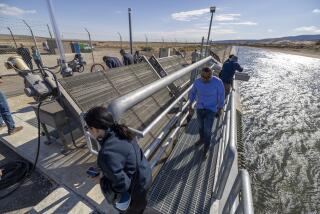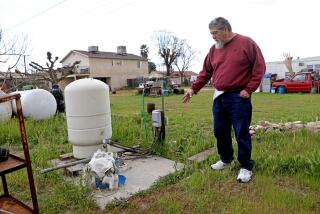Choking in Drought’s Grip : Water: For the first time in 50 years, wells are all but dry in the San Juan Creek watershed, forcing farming and ranching tenants to buy expensive, piped-in water.
- Share via
SAN JUAN CAPISTRANO — Fred Voorhees remembers the winter five years ago when rains swelled San Juan Creek and gave local kids a place to catch bass and channel catfish.
The cattle he raised on the sprawling Rancho Mission Viejo near here grazed on the rolling hills that rise above Ortega Highway.
But today, the creek is a dust bowl of dead willows and cattails. And the cattle have been moved to greener pastures.
“I’ve never seen it so bad,” said Voorhees, a foreman at the ranch just east of San Juan Capistrano.
The continuing Southern California drought has taken a toll on farmers, nursery owners and ranchers in the 110,000-acre San Juan Creek basin, officials say. For the first time in 50 years, the 14 agricultural wells that feed the region have run dry. And unless there is substantial rainfall soon, the dozen or so tenant farmers and nursery operators who till the surrounding fields may be forced out of business by summer.
“This is the worst it’s ever been,” Voorhees continued, standing Wednesday in the dry creek bed as warm Santa Ana winds blew dust around his boots.
“I don’t see how we are going to have enough water to keep all the tenants in business,” he added.
Shigeru Kinoshita, a veteran of 35 years of farming who runs a vegetable and strawberry farm eight miles downstream from Rancho Mission Viejo, agreed. He said the beautiful Southern California weather, which is so welcomed by the tourist industry, could be the demise of local agriculture.
“We’ve had too many Santa Ana wind conditions and high pressure systems, which are really unusual this time of year,” Kinoshita said. He predicted that if the area does not get 75% of the normal seasonal rainfall by the end of the month, “we’ll be in a lot of trouble.”
Local water officials said that the drought has virtually depleted much of the 113,000-acre aquifer that stretches under San Juan Creek from Cleveland National Forest west to the Pacific Ocean.
The wells tap into the aquifer, a layer of underground, porous rock and sand that holds water, at various locations along an eight-mile stretch of land.
As a result of the depletion, farmers and nursery owners have had to rely on imported water piped from nearby water agencies, according to William W. Knitz, general manager of the Santa Margarita Water District.
“This really shows you that we are in a drought,” said Knitz, who is also president of the San Juan Basin Authority board of directors.
Six months ago, the ranch all but abandoned the wells after spending close to $500,000 to hook up a seven-mile-long pipeline to the Santa Margarita Water District and a shorter line to the nearby Chiquita Canyon sewage-treatment plant, Knitz said.
That imported water so far has replaced the wells, which once provided free water to the tenant farmers.
Now the ranch and the farmers pay $350 per acre-foot for the imported water. (An acre-foot equals 326,000 gallons, which is enough to supply a family of four with drinking water for a year.)
“That is pretty expensive for water,” Voorhees said. “You never know how valuable water is until the wells run dry.”
Gilbert Aguirre, vice president of ranch operations, said that the imported water so far has been enough to forestall most negative effects of the drought.
But as summer approaches and the overall demand for water increases, Voorhees warned, the two utilities may not be able to supply enough water to keep the farm tenants in business.
The water table has now dipped to 50 feet underground, the lowest it has ever been in recorded history, water officials said. In seasons with normal or near-normal rainfall, the underground water level is between 20 to 30 feet from the surface.
Last week’s series of winter storms, which dumped more than two inches of rain in San Juan Capistrano, have done almost nothing to counter the effects of the drought in the basin.
“We would need at least 15 to 17 inches of rain per year over the next two years to get the wells back to an operational level,” Knitz explained. “I don’t think much of the rain water got into the ground water basin.”
Supporting his statement is the fact that the hillside grasses remain unusually brown and the creek bed is still parched.
Voorhees said that the drought has also affected the Rancho Mission Viejo’s Reata Cattle Co. operation. The company normally raises 800 head of cattle a year. But because the hills are so barren, about 600 head were moved to the company’s spread near Elko, Nev., to avoid starvation.
Other local farmers share the bleak predictions for the agricultural industry if the region does not receive substantial rainfall by April.
Bill Bathgate, a lifelong San Juan Capistrano orange grower, said that the drought is affecting water quality throughout the Capistrano Valley.
The lack of rainfall, he explained, has caused natural salt in the soil to accumulate near the surface rather than be leeched deeper by rain.
“Plants don’t like salty water,” Bathgate said.
He also said that it costs more money to pump water out of nearly empty wells.
“Not only does it take more power,” Bathgate said, “but the efficiency of the pump is decreased and you get less water.”
T. J. Meadows, general manager of the San Juan Basin Authority, said that the agency has been studying a plan to build two dams on San Juan Creek to keep up to 60% of runoff water from flowing into the ocean.
The dams would provide more than six billion gallons of agricultural and drinking water, Meadows said.
“This would really give us a chance to have a major water source that is not dependent on what naturally falls into the system” Knitz added.
The authority, which oversees ground water use in the water table under San Juan Creek and its two tributaries, Oso and Trabuco creeks, is seeking a $42-million federal grant from the Bureau of Water Reclamation.
Early versions of the proposal called for a 90-foot-high dam in a canyon near Ronald W. Caspers Wilderness Park, seven miles east of San Juan Capistrano on Ortega Highway.
Water officials have estimated that in a normal rainy season, water lost to the ocean could serve 18,000 families of four for a year.
In the meantime, Voorhees said, he is counting the days when he will once again see water flowing in the creek.
“It’s been four years now since any water flowed at all,” Voorhees said.
Dust Bowl The San Juan Creek Basin has lost almost all of its ground water due to the ongoing drought that has stricken Southern California. The creek once swelled during rainy seasons but has now been dry for four years.
More to Read
Sign up for Essential California
The most important California stories and recommendations in your inbox every morning.
You may occasionally receive promotional content from the Los Angeles Times.













